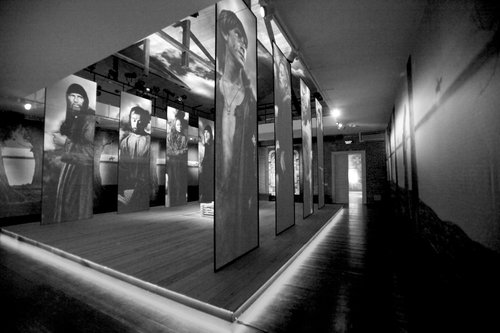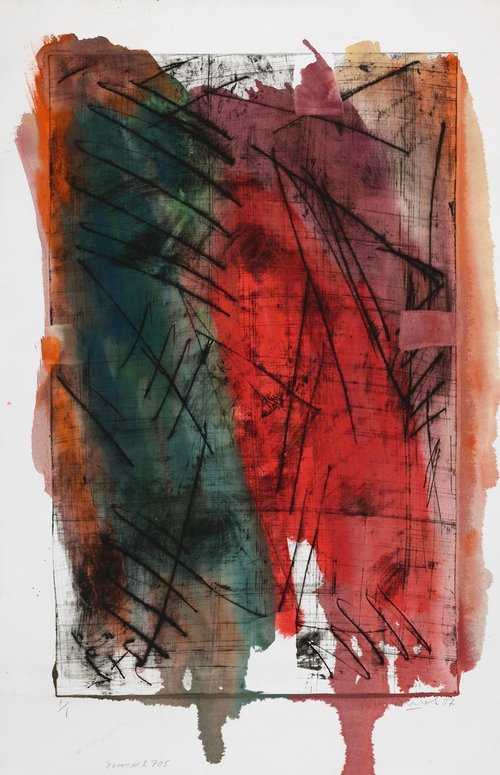Are New Trends Over at Moscow’s Tretyakov Gallery?

Artists with the banner ‘Everyone loves artists’ and the game ‘Art World’ works of the Zip art group at the exhibition ‘Generation XXI. Gift of Vladimir Smirnov and Konstantin Sorokin’ at the New Tretyakov Gallery. Photo: Vyacheslav Prokofiev/TASS
In Moscow, following the recent closing down of the New Trends Department at the State Tretyakov Gallery, many are asking what this means for Russia’s contemporary artists. The Art Newspaper Russia has looked into its complex history asking leading questions about what it means for the future.
Founded in 2001, a decade after perestroika and the breakdown of the Soviet Union, the recent closure of the Department of New Trends in the State Tretyakov Gallery has sparked off heated discussions. The art holdings that were formerly under its scope will now be managed by the Department of Art of the late 20th and 21st Centuries, a new and broad administrative division in the museum. Art historian and curator Andrei Erofeev who was the first head of New Trends at the Tretyakov, has written an open letter of protest, calling it ‘an inexcusable mistake, which will cause lasting damage to contemporary art in Russia, the cultural outlook of the public and the reputation of the Tretyakov Gallery itself’. In response, the following day the Tretyakov Gallery issued an official comment on its Telegram channel saying it ‘will continue to be engaged in contemporary art both in its exhibition practices and in the acquisition of funds’. But that has not quelled doubts in the art community rightly skeptical about this restructuring
It was back in the 1990s that the Tretyakov gallery began to turn towards contemporary art notably with a premiere of a long-awaited museum show about non-conformism called ‘Other Art’ (1990–1991). After a series of solo retrospectives, the museum acquired works by Vladimir Weisberg (1924–1985), Dmitry Krasnopevtsev (1925-1995) and other artists of the 1960s. A new fund was created within the Department of Soviet and Contemporary Painting, which made it possible to acquire works that were neither paintings, works on paper or sculpture, such as more conceptual works by Ilya Kabakov (1933–2023), Igor Makarevich (b. 1943), and Andrei Monastyrsky (b. 1949), some of which were given to the museum by the Ministry of Culture. By the end of the decade, ground had been prepared for the first permanent exhibition in the Krymsky Val venue, covering the entire 20th century, from the avant-garde to the 1990s, which gradually pushed Socialist Realism out from both sides.
Art historian Anna Romanova and Sasha Obukhova (now curator of the archive of the Garage Museum) were part of a working group who created this new permanent exhibition. Romanova recalls today: “We were between hammer and anvil. On the one hand there were academics who slammed doors at academic councils about it and wrote angry editorials about us in leading newspapers, and on the other hand our friends did not believe that the Tretyakov Gallery would be able to show contemporary art and they predicted our failure in advance. But there was such a lot of energy inside the museum itself that it felt as though a revolution was taking place. So the Department of New Trends had to be born.”
In parallel but completely independently, a collection of non-conformist art was being put together in the Tsaritsyno Museum-Reserve and a section representing the latest art trends was formed in 1989, with Andrei Erofeev at its helm, a time when Tsaritsyno was the ‘State Museum of Decorative and Applied Arts of the Peoples of the USSR’. Erofeev was most interested in ‘ephemeral works made without consideration of commercial or museum value’. Objects, installations – often large-scale, created specifically for temporary exhibitions - and the documentation of performances best reflected live artistic processes of the time. The collection was to become the basis for a future museum of contemporary art, and the artists donated their works to what was a museum in the making. Some works were purchased with funds from the Ministry of Culture, and other art works were simply left over from art events or site-specific projects.
These works were first housed was not in a crumbling down palace estate, but an anti-nuclear bunker. Major General Vsevolod Anikovich, then director of the Tsaritsyno Museum and a veteran of the Second World War, managed to secure this civil defense facility for the storage of museum art collections. In addition to the fruits of real artistic experiments, this bunker near the Moscow Ring Road housed works of arts and crafts and naive art.
By the end of the 1990s, the collection assembled by Erofeev had grown so large that Tsaritsyno refused to put new additions on its balance sheet. But in 1998, even this unaccounted part acquired state status. In 2001, with just one abstention, a meeting of the Academic Council of the State Tretyakov Gallery unanimously approved the recommendation of the Ministry of Culture to have the collection at Tsaritsyno transferred to it and in that same year the Tretyakov Gallery established a Department of the New Trends, headed up by Erofeev.
The first employees of the new department included the critics and art historians Sergei Epikhin, Evgenia Kikodze, Natalia Tamruchi. From the museum world was Anna Romanova and Natalia Sidorova also joined under Erofeev. Later from 2017 Irina Gorlova headed up New Trends until she left the Tretyakov Gallery this summer. From the outset, the curatorial team launched a lively new exhibition programme, but they still had to fight for space for the permanent exhibition. “They gave us dead space hidden away under the stairs, and soon the chief curator told us we could not even show things from the permanent collection there because there was no alarm system installed nearby,” recalls Erofeev. “Then I came up with the idea of stuffing large sheets of plywood on the walls, and artists such as Gosha Ostretsov, Georgy Litichevsky and Alexei Kallima painted murals on them. Between 2003 and 2005, every three months a new sheet of plywood would be stuck on top, and so the exhibition would change. Just imagine – years later it was all burnt down!”
In 2005, a permanent New Trends exhibition finally appeared in the enfilade on the upper floor, where temporary exhibitions are held today, which overlapped with the permanent exhibition of the 20th century. Yet in 2008, Andrei Erofeev was suddenly fired from the museum. The management of the department was immediately taken over by Kirill Svetlyakov, who had previously been his deputy and a curator of the temporary collection.
“In the main floor upstairs there were never any narratives, and visitors were guided only by names. Andrei came up with the idea of telling the history of art from the 1960s to the 1990s. I followed his concept and although the exhibition display changed in composition and subject matter, in character it remained the same,” recalls Svetlyakov. This new chapter in the history of New Trends is known for exhibitions where emerging currents clashed conceptually with various other currents, including socialist realism, revealing one or another conflict or problem. After each temporary exhibition, the main display was updated until it was finally dismantled in 2017, moving partially into the upper halls of the museum. But, “when they merged the exhibitions, they effectively ‘merged’ the department as well,” Svetlyakov maintains. “The art of the 1980s, 1990s and new media, it all went. Only paintings remained.”
Of course, some objects did manage to find a place upstairs, but they were the exceptions, explained in part by the lack of space. According to Irina Gorlova, who at the time was the head of New Trends, the hall dedicated to Moscow Conceptualism, which was already full, was turned into a restoration space.
Despite all of this, there was still ongoing commitment to build the collection. An exhibition staged in 2018 called ‘Art of the 2000s’ with most works on loan from private collections, revealed a new lacuna. During the years of Zelfira Tregulova's directorship from 2015 until last year, the holdings of the Tretyakov Gallery were significantly enriched, mainly due to gifts notably the hundred or so works of art from the 2000s-2010s given by the Vladimir Smirnov and Konstantin Sorokin Foundation, and later several hundred items were donated in 2020 by Joseph Baсkstein. Under Kirill Svetlyakov, the museum had already accepted nearly two thousand works from the collection of Leonid Talochkin and six hundred more were bought or accepted as gifts under the directorship of Irina Lebedeva. This near constant flow of generous gifts sharpened the problem of temporary storage.
Worries over the restructuring and closure of New Trends are focused mostly on works which are ‘unaccounted for’ numbering around 3,000, including those collected by Erofeev back in the Tsaritsyno days, still stored ‘under temporary numbers’ which now risk never becoming part of the nation’s Museum Fund. Many blame the Tretyakov staff for this, perhaps unfairly. “To sort out this complex body of artworks, you need to find the artist or heirs of each work and if we are talking about an art group, then all the members and obtain the necessary documentation from them, then write an expert opinion and submit an application to the fund’s expert acquisition committee, than wait for its next meeting so that the application would be approved or rejected, and only then the work can be either accepted or returned to the artist,” explains Gorlova. “Sometimes the artist is no longer alive and there is no heir. Besides, old gift deeds, from the early 2000s, are not valid now. The Tretyakov’s lawyers cannot let these works go to the commission as they need new documentation. Really important pieces have got stuck in temporary storage such as installations by Inspection Medical Hermeneutics, which broke up a long time ago.”
Kirill Svetlyakov added that some artists refused to authenticate their works, considering them unworthy of museification and yet without taking them away and a certain ballast has been formed by such pieces. Recently, anticipating the closure of the Krymsky Val venue for a big renovation at the end of 2026, efforts to sort out temporary storage have become even more active.
Since New Trends will remain as a division in the museum despite being one that has lost its former independence, one assumes that this work will continue. That being said, the new Department of Art of the Late 20th and 21st Centuries will be headed by Natalia Alexandrova, a specialist in painting and an old-timer of the State Tretyakov Gallery, leading to fears that some works will be quickly rejected out of hand, without making it to the expert commission. “Even new employees at the museum, who appreciate this art and work with it with white gloves, do not always understand how individual parts of an art installation might relate to each other. It is a problem when this material is handled by people who do know how to show and understand it,” complains Andrei Erofeev.
Those who are involved in creating this new, enlarged department, themselves are expecting the part of the permanent exhibition dedicated to ‘new trends’ to fall into anabiosis. It is already being emaciated, for example, recently a painting called ‘Stalin and the Bear’ by Leonid Sokov (1943–2018) was taken down from the walls of the museum into storage because of complaints from sensitive visitors. But perhaps anabiosis will make it possible to survive this challenging chapter with minimal losses.
This article was first published in Russian on the website of The Art Newspaper Russia on 28 October, 2024.













